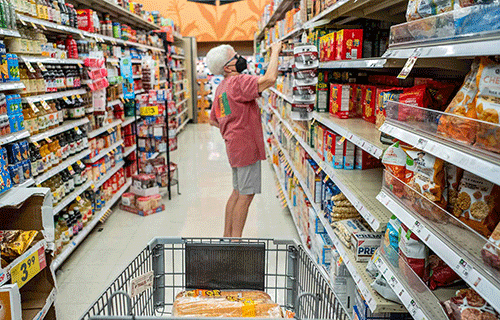Although there is no certainty as to when the current interest hike cycle will end, a major player in Namibia’s financial market expects one or two more interest rate hikes before a peak is reached.
What is however certain is that elevated and excessive living costs in the domestic economy will continue to weigh heavily on consumer demand.
Responding to queries from New Era, assistant portfolio manager at Old Mutual Investment Group, Tumelo Thudinyane, believes one or two more interest rate increases will happen before the central bank abandons the strategy to rein in inflation.
“The upcoming Bank of Namibia (BoN) Monetary Policy Committee announcement on 14 June 2023 holds significance as it provides insights into the direction of the country’s monetary policy. The Bank of Namibia’s tone at its previous interest rate announcement was largely unchanged from its previous stance – hawkish but largely data dependent,” Thudinyane stated.
He further noted that Namibia is currently in its sixth interest rate hiking cycle since 1991, adding that relative to the previous hiking cycles, the current cycle is the third most aggressive in terms of the total cumulative basis points by which BoN increased interest rates.
350 points in 18 months
BoN has hiked the repo rate by 350 basis points in the past 18 months since 31 January 2022.
The central bank said this was considered the most appropriate monetary policy stance to continue anchoring inflation and safeguarding the one-to-one peg with the rand.
Thudinyane continued that in terms of the key interest rate differential between Namibia and South Africa, BoN has deviated from South African monetary policy and as such Namibia now has a 100-basis point differential under South Africa’s key policy rate of 8.25%.
Thudinyane stated: “Typically, the BoN maintains a 25-basis point buffer above the South African repo rate. Naturally, money flows where interest rates are higher and where there are higher interest-bearing financial instruments.
“The current repo rate differential below South Africa’s repo rate may come at a cost to the economy in terms of investments and further capital flows from Namibia to South Africa, which typically become noticeable and more pronounced at a 75-basis point differential in terms of capital flows either in or out of the country,” he said.
Thudinyane added that the central bank’s current assessment is that risks to the inflationary outlook remain particularly skewed to the upside, with BoN baseline estimates suggesting inflation will average 6.1% and 4.3% in 2023 and 2024 respectively.
He pointed out that the main risk sentiments in this regard emanate from prolonged stubbornness in core inflation and second-round effects on food price inflation emanating from a weaker exchange rate.
Meanwhile, BoN projects Namibia’s economic growth performance to slow down during 2023 and 2024, due to weaker global demand. The central bank’s Real GDP estimates have moderated downwards to 3% and 2.9% in 2023 and 2024 respectively, with the main risks to domestic growth being global monetary policy tightening, reduced consumer spending powers, the high costs of key import items and all of this amidst the backdrop of a weaker exchange rate.
Moreover, local stock brokerage, Simonis Storm Securities (SSS), recently cautioned that based on the current repo rate of 7.25% and prime lending rate of 11%, that elevated living costs will continue to weigh heavily on consumer demand.
This, in turn, is expected to impact the affordability of loans for new buildings, which is anticipated to further deteriorate and contract the already suffering domestic construction industry.
This precarious state of affairs was brought to the fore by SSS in its Building Statistics report for April 2023. In the report, SSS stated a 25bps rate hike is anticipated later this month.
If accurate this would increase the repo rate to 7.50% and the prime rate to 11.25% and as a result, the average home loan interest rate will increase to about 12.25% (prime plus one).
Rising living costs
When asked how already struggling Namibians can deal with the escalating cost of living, Old Mutual’s group marketing, public affairs and sustainability executive, Mignon du Preez, said being proactive and figuring out strategies to lessen the effects of rising living expenses are crucial.
“Budgeting and financial planning should be the first step, but pricing comparison should come next.
Analyse your spending and search the market for ways to save costs. For the greatest offers, research several options and compare rates,” Du Preez stated.
She further advised consumers to think outside the box, take into account alternatives in addition to conventional budgeting and to look for creative methods to cut costs and save money.
“In addition to saving money, think about ways to boost your earnings. Invest in learning new skills or look into part-time employment opportunities. Having several sources of income might help offset rising expenses”.
Du Preez also advocates seeking professional assistance, advising consumers to ask experts for financial assistance as this might result in valuable insightful geared to a particular situation.
She further encourages a sustainable lifestyle that includes adopting energy-saving techniques, such as buying solar panels or switching to LED lamps, and participating in neighbourhood programmes that encourage resource sharing, such as tool libraries or car pooling.
“Keep in mind that reducing the effects of increased living expenses can be accomplished through group efforts and well-informed decision-making. You can find innovative ways to deal with the effects of a rising cost of living by combining price comparison and investigating unusual possibilities. We can overcome these obstacles and prosper in our shifting economic environment if we work together,” Du Preez advised.


